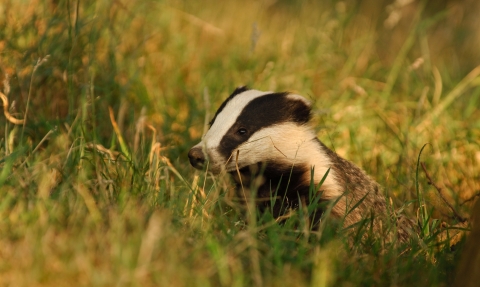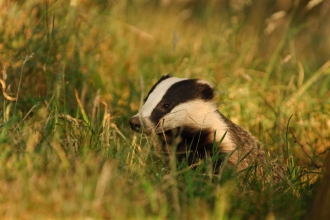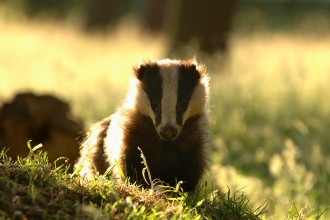
badger c. Andrew Parkinson/2020VISION
Vaccinating Badgers
The Badger Cull
The Department for Environment, Food and Rural Affairs, Defra, has granted licenses in England to cull badgers where there’s a high, medium and low risk of cattle being infected with bTB. Badgers are being culled because they can carry bovine Tb and pass on the disease to other animals; however, badgers are not the main route of infection for farmers’ herds - that comes from cattle to cattle contact. There are now 32 cull zones in at least the following counties: Cornwall, Devon, Dorset, Wiltshire, Gloucestershire, Herefordshire, Cheshire, Somerset and Staffordshire. This includes one cull zone in the Low Risk Area in Cumbria.
A Freedom of Information request (FOI) was put in by ‘Wounded Badger Patrol - Cheshire’, which after going to an appeal, revealed that Cheshire Police charged the Home Office £831,093.00 for the costs of policing the badger cull in Cheshire during 2017. During 2017 736 badgers were killed, therefore costing taxpayers approximately £1130 per badger. And this is just policing costs!
Wounded Badger Patrol Cheshire put in a second FOI relating to the number of badgers tested for bTB by Nottingham University during the 2017 cull. The information released showed just 80 badgers were tested, and the interim results suggest that the prevalence will not be statistically different from that found in the roadkill surveys in the area, which showed approximately 14% of badgers tested positive for bTB.
Cheshire Wildlife Trust is currently working in partnership with the Cheshire Badger Vaccination Programme to start vaccinating badgers in 2019.
What is bTB?
Bovine tuberculosis (bTB) is a highly infectious disease of cattle which devastates thousands of farming businesses annually. Since the mid-1980s, the incidence of bTB in cattle has increased substantially, creating an economic burden on the taxpayer and the farming industry, as infected cattle must be culled.
As well as cattle, Bovine TB affects other mammals including humans, badgers, deer, goats, pigs, dogs and cats.
Key cull facts…
- The current badger culling policy to control bovine TB was introduced by the Government in 2011. Seven of the 17 culls to date have not achieved their targets of numbers of badgers to be killed.
- The Government has relaxed the parameters that culls need to meet before being licensed, moving further away from the recommendations of independent scientific experts.
- The Government’s own Independent Expert Panel stated that culls were ineffective and inhumane, with at least 7% of badgers known to have been killed inhumanely in 2014.The Government disbanded the Panel in 2015 but data indicated this figure has not changed.
- Badgers and their setts are legally protected under the Protection of Badgers Act 1992, in England and Wales. It is an offence to:
o Wilfully kill, injure or take a badger (or attempt to do so).
o Cruelly ill-treat a badger.
o Dig for a badger.
o Intentionally or recklessly damage or destroy a badger sett, or obstruct access to it.
o Cause a dog to enter a badger sett.
o Disturb a badger when it is occupying a sett.
- New research shows that close contact between badgers and cattle is rare, so the likelihood of direct transmission of the disease is low, calling into question the very reason to cull.Indirect transmission remains possible through the soil and dung.
- Costs per badger from culling are over £5,000 compared to under £700 per badger vaccinated.
- Defra’s Chief Veterinary Officer recommended that “consideration should be given to monitoring the disease status of badgers as well as badger populations within cull areas” as yet no culled badger has been tested for TB.
- The Republic of Ireland is reviewing its 30 year policy on culling in 2017 and is focusing on badger vaccination.
What do we believe?
-
We want to see the eradication of bovine tuberculosis (bTB) in cattle, but a badger cull is not the answer.
Scientific evidence indicates that a cull is unlikely to make a substantive improvement in cattle infection rates and may make matters worse. As badgers live in groups, culling will disturb the remaining group members, which is likely to cause increased movement of remaining badgers, potentially bringing infected and uninfected badgers and cattle into contact. We believe the emphasis of all our efforts should be to find a long-term solution and we are calling for the Government to end its policy of culling badgers.
-
This is a cattle problem, not a badger problem.
The control of Bovine TB in cattle should be the main focus of everyone’s efforts to control this problem. The evidence shows that badgers are not the primary cause of the spread of TB in cattle: the primary route of infection is via cow-to-cow contact. Tackling the disease should therefore include the following measures.
o Better biosecurity: all possible measures should be pursued to prevent disease transmission on farms.
o Stricter movement controls: to minimise the risk of spreading disease when cattle are transported.
o Improved TB testing: to increase detection of the disease - currently, many infected cattle are missed.
o Badger vaccination: support landowners to use the injectable Badger BCG vaccine and continue development of an oral badger vaccine.
o Cattle vaccination should be a priority: The Government has failed to develop one for TB. UK Cattle are already vaccinated for up to 16 diseases, so why should TB be different?
-
The cull is scientifically unsound.
The results of the previous badger culls indicate that this policy is flawed and unsupported by the evidence. In 2014 Rosie Woodroffe, ecologist and former member of the Independent Scientific Group on Cattle TB, deemed the cull ‘scientifically rubbish’ in response to changing Government targets. Culling has been shown to be more expensive, less effective than other bTB control mechanisms and the free-shooting of badgers has been shown to be an inhumane method of killing.
Our view is it is better to concentrate on cattle to cattle transmission and improving bio-security to avoid badgers and cattle coming into contact. Vaccination of cattle in the long-term and vaccination of badgers as a short-term measure are more effective means of control.
What does the vaccination process involve?
In 2012 we embarked upon a pilot badger vaccination programme at our Bickley Hall Farm HQ because we wanted to show that vaccination was a valuable component of the TB eradication strategy. This pilot ended in autumn 2015. We have also worked with a number of local landowners in south Cheshire to start vaccination programmes on their own farms.
What are The Wildlife Trusts doing?
The Wildlife Trusts have been working on the issue of bTB and its links to badgers for several years. During this time our activities has included:
- undertaking badger vaccination programmes since 2011* on our nature reserves and in the wider countryside in partnership with vets, farmers and landowners (14 Wildlife Trusts have been involved in these vaccination programmes)
- standing up for badgers in local and national media
- petitioning the Prime Minister to drop the Government’s failed badger cull policy and develop an alternative strategy to tackle bTB
- lobbying the government to develop a cattle vaccine and implement an all-encompassing badger vaccine strategy
- collating, summarising and presenting the science on the spread of bTB
- encouraging our members and supporters to write to their MPs to press for a different approach to eradicating Btb, without culling badgers.
- supporting and promoting e-petitions to stop the cull
What can you do?
1. Email your MP to ask them to call for any furhter culling to be stopped
Email your local MP to ask them to continue to put pressure on the Government to scrap their cull plans and prioritise badger vaccination. Make sure you personalise your email with your own thoughts.
2. Email your MEP about the EU cattle vaccine ban
Ask your MEP to press for the EU ban on a cattle vaccine to be lifted.
Find the details of your MEP. A cattle vaccine is the long term solution to the bTB problem, but EU rules currently prevent it from being tested and used in this country.
3. Keep up-to-date
We will be posting updates on the proposed badger cull in Cheshire on our news pages.
Here is a simple summary of the science.
Paul Wilkinson, Head of Living Landscape at The Wildlife Trusts, has written a summary highlighting the "Cost of culling" in 2014.
Bovine TB: pilot culls ineffective. Read our latest briefing document
Locally Wirral and Cheshire Badger Group are active in ongoing badger vaccinations.
4. Support badger vaccination programmes
You can donate now towards a Wildlife Trust's badger vaccination programme. Funds help to pay for vaccines, training, equipment and licenses.
5. Contact Natural England
Natural England’s bTB enquiry line advisors are available to help answer any questions you may have about the cull licencing process:
Tel: 0300 060 0550 - lines are open during office hours
Post: Natural England, BM 6283, London, WC1N 3XX
Email: bTB@naturalengland.org.uk


